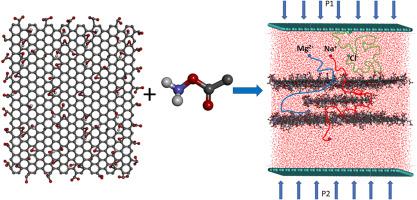Mechanisms determining water permeability and ion selectivity of multilayered glycine-functionalized graphene oxide membranes in saline water reverse osmosis processes: A computational investigation
IF 9
1区 工程技术
Q1 ENGINEERING, CHEMICAL
引用次数: 0
Abstract
Non-Equilibrium Molecular Dynamics simulations were performed to examine in detail the mechanisms involved in a reverse osmosis process for the removal of monovalent (Na+, Cl−) and divalent (Mg2+) ions from saline water, using multilayered glycine-functionalized graphene oxide (GO) membranes. We varied parameters such as the degree of functionalization of the GO flakes and the structural flexibility of the membranes and examined their performance in a wide range of applied pressure gradients. In all models examined, water permeability was found to be almost 2 orders of magnitude larger compared to that in conventional reverse osmosis (RO) membranes. High structural flexibility of the membranes was found to increase water permeability due to the formation of additional nanochannels that favor faster water transport. Functionalization of the GO flakes by the glycinate groups resulted in a decrease in water permeability due to the formation of a denser hydrogen-bonding network within the membranes. Three main mechanisms were identified regarding ion selectivity. Due to the overall negative charge of the membranes, the strong adsorption of the Mg2+ ions onto the GO flakes resulted in their full rejection. Weaker adsorption of the Na+ ions led only to their partial rejection. At the same time, the electrostatic repulsion of the Cl− ions by the membranes was found to result in almost full removal levels at high pressure gradients. The rejection of the monovalent ions was found to decrease with the structural flexibility of the membranes and increase with the functionalization of the GO flakes, in response to the changes observed in water permeability on these membrane modifications. The pressure-dependent deformability of the structurally flexible membranes combined with charge accumulation close to the membrane's entrance, resulted in a non-monotonic dependence of the monovalent ion rejection on the applied pressure difference.

决定盐水反渗透过程中多层甘氨酸功能化氧化石墨烯膜透水性和离子选择性的机理:计算研究
我们利用多层甘氨酸功能化氧化石墨烯(GO)膜进行了非平衡分子动力学模拟,详细研究了从盐水中去除一价(Na+、Cl-)和二价(Mg2+)离子的反渗透过程所涉及的机理。我们改变了 GO 薄片的功能化程度和膜的结构柔韧性等参数,并考察了它们在各种应用压力梯度下的性能。在所有研究的模型中,我们发现与传统的反渗透膜相比,透水性几乎大了两个数量级。由于形成了更多的纳米通道,有利于加快水的传输速度,因此发现膜的高结构柔性提高了透水性。甘氨酸基团对 GO 薄片进行官能化后,由于膜内形成了更密集的氢键网络,从而降低了透水性。在离子选择性方面发现了三种主要机制。由于膜的整体带负电荷,Mg2+ 离子在 GO 薄片上的强吸附性导致其被完全排斥。对 Na+ 离子的吸附较弱,只能将其部分排斥。同时,在高压梯度下,膜对 Cl- 离子的静电排斥几乎达到了完全去除的水平。研究发现,膜对单价离子的排斥作用会随着膜结构的灵活性而降低,并随着 GO 片的功能化而增加,这与在这些膜改性时观察到的水渗透性变化是一致的。结构柔性膜随压力变化的变形能力加上靠近膜入口处的电荷积累,导致单价离子排斥量与所施加的压力差呈非单调关系。
本文章由计算机程序翻译,如有差异,请以英文原文为准。
求助全文
约1分钟内获得全文
求助全文
来源期刊

Journal of Membrane Science
工程技术-高分子科学
CiteScore
17.10
自引率
17.90%
发文量
1031
审稿时长
2.5 months
期刊介绍:
The Journal of Membrane Science is a publication that focuses on membrane systems and is aimed at academic and industrial chemists, chemical engineers, materials scientists, and membranologists. It publishes original research and reviews on various aspects of membrane transport, membrane formation/structure, fouling, module/process design, and processes/applications. The journal primarily focuses on the structure, function, and performance of non-biological membranes but also includes papers that relate to biological membranes. The Journal of Membrane Science publishes Full Text Papers, State-of-the-Art Reviews, Letters to the Editor, and Perspectives.
 求助内容:
求助内容: 应助结果提醒方式:
应助结果提醒方式:


